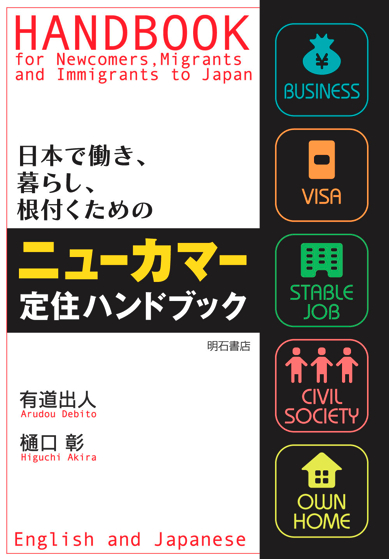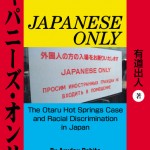mytest
Hi Blog. A few weeks ago I was invited to retool my recent Japan Times article on the Nikkei Repatriation Bribe for an academic website. After doing so (and integrating a point I had neglected about the bribe being one way to save on pension monies), they decided that I had enough outlets (what with this blog and the JT) and thought it wasn’t quite original enough. Ah well. I like how it turned out anyway, so I’ll post it here as the outlet. Thanks for reading it. Debito in Sapporo
======================================
THE NIKKEI REPATRIATION BRIBE: WHY IT’S A RAW DEAL FOR NJ
By Arudou Debito. Debito.org May 8, 2009
One cannot read the news without hearing how bad the world economy has become, and Japan is no exception. Daily headlines proclaim what was once considered inconceivable in a land of lifetime employment: tens of thousands of people fired from Japan’s world-class factories. The Economist in April referred to Japan’s “two lost decades”, suggesting that modest economic gains over the past five years will be completely wiped out, according to OECD forecasts for 2009.
Cutbacks have bitten especially deeply into the labor market for non-Japanese workers. The Health, Labor and Welfare Ministry reports that in the two months up to January 2009, more than 9,000 foreigners asked “Hello Work” unemployment agencies for assistance — eleven times the figure for the same period a year earlier. The Mainichi Shinbun reported (April 7, 2009) that 1,007 foreign “trainees”, working in Japanese factories, were made redundant between October 2008 and January 2009 alone.
In the same report [1], the labor ministry asserts that non-Japanese are unfamiliar with Japan’s language and corporate culture, concluding that (despite years of factory work) they are “extremely unre-employable” (saishuushoku ga kiwamete muzukashii).[2] So select regions are offering information centers, language training, and some degree of job placement. Under an emergency measure drawn up by the ruling Liberal Democratic Party in March, the Japanese government began from April 1 offering workers of Japanese descent (nikkei) working here on “long-term resident” visas — a repatriation package. Applicants get 300,000 yen, plus 200,000 yen for each family dependent, if they return to their own country. If they take up the offer before their unemployment benefit runs out, they get 100,000 yen added to each sum for each month outstanding.
This sounds good. After all, why keep people here who cannot find a job? But read the small print of the proposal: The retraining measures only target 5,000 people, a tiny fraction of the 420,000-plus nikkei already in Japan. Of course, the offer extends to none of the 102,018 “trainees” (mostly Chinese) that Japan’s factories received in 2007 alone. Hundreds of thousands of people are on their own.
From this, it is clear the government is engaging in damage control by physically removing a small number of people from Japan’s unemployment rosters – the nikkei – and doing a dramatic U-turn in imported-labor policies. A twenty-year-old visa regime, based on economic and political contradictions, official and unofficial cross-purposes, unregulated corrupt programs, and a mindset of treating people as mere work units, is coming to a close. This is an enormous policy miscalculation by the Japanese government thanks to a blind spot of using racially based paradigms to create a new domestic workforce.
First, let’s return to the “repatriation offer” and consider its implications. Although the sum of 300,000 yen may appear magnanimous, it comes with two built-in ironies. One is the sense that history is repeating itself. These nikkei beneficiaries are the descendents of beneficiaries of an earlier scheme by the Japanese government to export its unemployed. A century ago, Japan sent farmers to Brazil, America, Canada, Peru and other South American countries. Over the past two decades, however, Japan has brought nikkei back under yet another scheme to utilize their cheap labor. This time, however, if the nikkei take the ticket back “home,” they can’t return — at least not under the same preferential work visa. The welcome mat has been retracted.
The other irony is the clear policy failure. Close to half a million nikkei are living in Japan, some for up to twenty years, paying taxes, social security, and nenkin retirement pensions. They have worked long hours at low wages to keep Japan’s factories competitive in the world economy. Although the nikkei have doubled Japan’s foreign population since 1990, minimal seniority and entrenchment has taken a heavy toll on these long-termers; books have been written on how few foreigners, including the Nikkei, have been assimilated.[3] Now that markets have soured, foreigners are the first to be laid off, and their unassimilated status, even in the eyes of the labor ministry, has made many of them unmarketable.
Put bluntly, the policy is: train one percent (5,000) to stay; bribe the rest to go and become some other country’s problem. In fact, the government stands to save a great deal of money by paying the nikkei a pittance in plane fares and repatriation fees, while keeping their many years of pension contributions (usually about 15% of monthly salary). By using this economic sleight-of hand, offering desperate people short-term cash if they foresake their long-term investments, this anti-assimilation policy becomes profitable for the government, while beggaring foreigners’ retirements.
Now consider another layer: This scheme only applies to nikkei, not to other non-Japanese workers such as the large number of Chinese “trainees” also here at Japan’s invitation. How has a government policy for a developed country disintegrated into something so ludicrous, where even officially sanctioned exclusionism has a hierarchy?
The background, in brief, is this: Japan faced a huge blue-collar labor shortage in the late 1980s, and realized with the rise in the value of the yen and high minimum wages, that its exports were being priced out of world markets.
Japan’s solution, like that of many other developed countries, was to import cheaper foreign labor. Of course, other countries with a significant influx of migrant labor, also had problems with equitable working conditions and assimilation.[4] However, as a new documentary, Sour Strawberries: Japan’s hidden “guest workers” vividly portrays, what made Japan’s policy fundamentally different was a view of foreign labor through a racial prism. Policymaking elites, worried about debasing Japan’s allegedly homogeneous society with foreigners who might stay, maintained an official stance of “no immigration” and “no import of unskilled labor”.
However, that was tatemae — a façade. Urged by business lobbies such as Nippon Keidanren, Japan created a visa regime from 1990 to import foreign laborers (mostly Chinese) as “trainees”, ostensibly to learn a skill, but basically to put them in factories and farms doing unskilled “dirty, difficult, and dangerous” labor eschewed by Japanese. The trainees were paid less than half the minimum wage (as they were not legally workers under Japanese labor law) and received no social welfare.
Although some trainees were reportedly working 10, 15 and in one case even 22-hour days, six to seven days a week including holidays, they received wages so paltry they beggared belief — in some cases 40,000 yen a month. A Chinese “trainee” interviewed in Sour Strawberries said he wound up earning the same here as he would in China. Others received even less, being charged by employers for rent, utilities, and food on top of that.
Abuses proliferated. Trainees found their passports confiscated and pay withheld, were denied basic human rights such as freedom of association or religious practice, were harassed and beaten, and were even fired without compensation if they were injured on the job. One employer hired thugs to force his Chinese staff to board a plane home. But trainees couldn’t just give up and go back. Due to visa restrictions, requiring significant deposits before coming to Japan (to put a damper on emigration), Chinese took out travel loans of between 700,000 to one million yen. If they returned before their visas were up, they would be in default, sued by their banks or brokers and ruined. Thus they were locked into abusive jobs they couldn’t complain about or quit without losing their visa and livelihoods overseas.
As Zentoitsu Worker’s Union leader Torii Ippei said in the documentary, this government-sponsored but largely unregulated program made so many employers turn bad, that places without worker abuses were “very rare”. The Yomiuri Shinbun (April 11, 2009) reported a recent Justice Ministry finding of “irregularities” at 452 companies and organizations involving trainees in 2008 alone, including hundreds of cases of unpaid overtime and illegal wages. Cases have been remanded to public prosecutors resulting in the occasional court victory, such as the 2008 landmark decision against the Tochigi strawberry farm that became the sobriquet for the documentary, have resulted in hefty (by Japanese standards) punitive judgments.
But these “trainees” were not the only ones getting exploited. 1990 was also the year the “long term resident” visa was introduced for the nikkei. Unlike the trainees, they were given significantly higher wages, labor law protections and unlimited employment opportunities — supposedly to allow them to “explore their heritage” — while being worked, in many cases 10 to 15 hours a day, six days a week.
Why this most-favored visa status for the nikkei? The reason was racially based. As LDP and Keidanren representatives testified in Sour Strawberries, policymakers figured that nikkei would present fewer assimilation problems. After all, they have Japanese blood, ergo the prerequisite cultural understanding of Japan’s unique culture and garbage-sorting procedures. It was deemed unnecessary to create any integration policy. However, as neighborhood problems arose, visible in the “No Foreigner” shop signs around nikkei areas and the Ana Bortz vs. Seibido Jewelry Store (1998-9) lawsuit, the atmosphere was counterproductive and demoralizing for an enthusiastic workforce.[5] A nikkei interviewed in the documentary described how overseas she felt like a Japanese, yet in Japan she ultimately felt like a foreigner.
Under these visa regimes, Japan invited over a million non-Japanese to come to Japan to work — and work they did, many in virtual indentured servitude. Yet instead of being praised for their contributions, they became scapegoats. Neighborhoods not only turned against them, but also police campaigns offered years of opprobrium for alleged rises in crime and overstaying (even though foreign crime rates were actually lower than domestic, and the number of visa overstayers dropped every year since 1993). Non-Japanese workers were also bashed for not learning the language (when they actually had little time to study, let alone attend Japanese classes offered by a mere handful of merciful local governments) — all disincentives for settling in Japan.
This is what happens when people are brought into a country by official government policy, yet for unofficial purposes at odds with official pledges. Japan has no immigration policy. It then becomes awkward for the government to make official pronouncements on how the new workforce is contributing to the economy, or why it should be allowed to stay. So the workforce remains in societal limbo. Then when things go wrong — in this case a tectonic macroeconomic shift — and the policy fails, it is the foreigners, not the government, who bear the brunt.
And fail the policy did on April Fools’ Day 2009, when the government confirmed that nikkei didn’t actually belong in Japan by offering them golden parachutes. Of course, race was again a factor, as the repatriation package was unavailable to wrong-blooded “trainees,” who must return on their own dime (perhaps, in some cases, with fines added on for overstaying) to face financial ruin.
What to do instead? In my view, the Japanese government must take responsibility. Having invited foreigners over here, it is necessary to treat them like human beings. Give them the same labor rights and job training that you would give every worker in Japan, and free nationwide Japanese lessons to bring them up to speed. Reward them for their investment in our society and their taxes paid. Do what can be done to make them more comfortable and settled. Above all, stop bashing them: Let Japanese society know why foreigners are here and what they have contributed to the country.
Don’t treat foreigners like toxic waste, sending them overseas for somebody else to deal with, and don’t detoxify our society under the same racially-based paradigms that got us into this situation in the first place. You brought this upon yourselves through a labor policy that ignored immigration and assimilation. Deal with it in Japan, by helping non-Japanese residents of whatever background make Japan their home.
This is not a radical proposal. Given the low-birthrate of Japan’s aging society, experts have been urging you to do this for a decade now. This labor downturn won’t last forever, and when things pick up again you will have a younger, more acculturated, more acclimatized, even grateful workforce to help pick up the pieces. Just sending people back, where they will tell others about their dreadful years in Japan being exploited and excluded, is on so many levels the wrong thing to do.
NOTES:
[1] Ministry of Health, Welfare, and Labour report at http://www.mhlw.go.jp/houdou/2009/03/dl/h0331-10a.pdf
[2] Original Japanese reads in the above report 「日本語能力の不足や我が国の雇用慣行の不案内に加え、職務経験も十分ではないため、いったん離職した場合には、再就職が極めて厳しい状況にあります。]
[3] See Takeyuki Tsuda, Strangers in the Ethnic Homeland.[add source information]
[4] For examples of issues of migrant labor and assimilation in Spain, South Korea, and Italy as well as Japan, see Takeyuki Tsuda, ed. Local Citizenship in Recent Countries of Immigration: Japan in Comparative Perspective. Other examples, such as the Turks in West Germany, Poles in the British Isles, Algerians and Moroccans in France, and Africans throughout Western Europe, have warranted significant media attention over the decades, but the labor mobility created by EU passports have arguably made the counterarguments against migration less “homogeneous-society” and “racially-based” in origin than in the Japanese example. [recheck and revise last sentence]
[5] For a description of the Ana Bortz and other cases of Nikkei exclusionism, see https://www.debito.org/bortzdiscrimreport.html
Arudou Debito, Associate Professor at Hokkaido Information University, is a columnist for The Japan Times and the manager of the debito.org daily blog. The co-author of Handbook for Newcomers, Migrants, and Immigrants to Japan, and author of Japanese Only: The Otaru Hot Springs Case and Racial Discrimination in Japan (Akashi Shoten, Inc.), Arudou is organizing nationwide showings of Sour Strawberries around Japan late August-early September; contact him at debito@debito.org to arrange a screening. You can purchase a copy of the documentary by visiting http://www.cinemabstruso.de/strawberries/main.html
A briefer version of this article was published in The Japan Times on April 7, 2009






10 comments on “Revamped article on the Nikkei Repatriation Bribe”
“Given the low-birthrate of Japan’s aging society, experts have been urging you to do this for a decade now. This labor downturn won’t last forever…”
That’s the most glaring inanity of the entire affair, Debito. The UN says Japan needs to invite 17 million immigrants in, & even the uber-xenophobic LDP acknowledges 10 million, yet here we have them pushing out even the most racially palatable at the first opp. Not to mention the proposed gaijin cards/fines. I think of a variation on the Borg–assimilation is futile.
Sheer demographic suicide, consciously at that. They know there is no way around a boost in immigration (even if J-women suddenly started having kids like catholics, it’d be too late to arrest the looming trouble). Most sadly of all, mention the above immigration figures to your students or friends and see how comfortable they are with the notion of a mass influx. The LDP merely reflects the larger xenophobia on the street. Victims of false narratives about homogeneity/nihonjinron since birth, they are constitutionally incapable of embracing the changes they need to survive as a nation.
The GOJ and the country in general will do whatever it wants without a care in the world for anyone non Japanese. It`s sad, ridiculous, unfair and xenophobic. But still it`ll continue because the mindset is “Japanese is Best.” There is also no outside pressure to push Japan to change. The rest of the world still does business with them and allows them to hold key positions in international organisations. So basically the message from other nations to the GOJ is “we need you and keep up the good work.” This won`t help anything.
I thought that if you left Japan for good you could claim your pension back? When I left the first time I claimed all mine back. Although I was on JET so perhaps that is relevant?
— Check your data again, please.
Kurisu,
Yes, you can claim your pension. Yet, you can get up to three years of your pension contribution back irregardless of how long you paid into it. As Debito’s article here states some of these Nikkei have been here for twenty years, with most in the teens. It’s a raw deal!
I could understand ending the Nikkei immigration policy but to encourage people to leave Japan who have made the country their home goes beyond normal xenophobia. I think Japan’s days as an economic giant are over.
The amount you can claim back is capped at around 250,000 yen.
http://www.sia.go.jp/e/pdf/english.pdf
Which would indeed make it a raw deal.
Be careful! If you take the three year amount you give up all rights to a full pension if you should resume employment in Japan again. I took the two years worth in 1996. I then returned to Japan and started with a new employer. I will retire from this employer with a smallish pension when I’m 65. I would lose this pension if I took out three years worth upon retirement now.
I have been trying to wrap my head around why it is Japan has failed to do what it can to cauterize the wound that is being caused by their low birth rate. I can only venture to say then that Economic collapse is obviously infinitely more preferable to the Japanese than Immigration.
That a people who were so dissatisfied with the United States Immigration Act 1924/1927, and that sent such huge numbers of people to Hawaii, Chile, Brazil and Peru should now have a problem with immigrants coming to their shore is mind boggling.
The best solution – let Japan stew in the sauce it is so busily cooking.
There are chicks being hatched as we speak boys and girls and they’ll be coming home to roost soon enough.
Hi Debito,
I am on your side when it comes to this issue. Here are five points:
1. As best I can tell (unless it was modified *after the fact*, which is possible) the original notice about the repatriation payment said the nikkei could come back after “当分の間”.
You link to the document yourself in your first footnote. So just for the record, gosh, at the whim of the government at some future time, Nikkei who receive the payment could come back (as per the original plan).
2. I believe aside from the immediate human rights abuses here, the most serious issue is that of a flagrant abuse of law and the constitution. This is a demonstration of just how arbitrary the powers that be in Japan are towards people they have granted visas to. Heck maybe even citizenship can be reversed …
Mr. Sakanaka explains the constitutional issue really well:
http://blog.livedoor.jp/jipi/archives/51254002.html
Also check this out:
Questions:
http://www.sangiin.go.jp/japanese/joho1/kousei/syuisyo/171/syuh/s171215.htm
Answers:
http://www.sangiin.go.jp/japanese/joho1/kousei/syuisyo/171/touh/t171215.htm
I can’t see where the word “合理的” comes up in the original law, but that seems to be the government excuse for not following the law.
Can we be optimistic that the DPJ will be better here? I’m not at all sure.
3. The government is apparently now saying that they will allow people back after three years. It’s not clear to me is this is guaranteed or just a kind of promise. Given that none of this is truly lawful, maybe it doesn’t matter.
Here is the link:
http://www.asahi.com/politics/update/0511/TKY200905110259.html
4. Ampontan, a semi-popular blog, addresses this issue in a very recent post. It’s long and very hard to read because he fumes against the liberal media almost every other sentence. But he does add some extra information. Apparently, Ampotan contacts a sort of deep throat, who reveals the real reason for why the repatriation bribe is okay. Get this, it’s only focused on stupid and lazy Brazilians, not the rest of them. (Oh boy, the light bulbs.) I can hear some bureaucrat saying, “Those dumbf*cks.”
Indeed, if Ampotan’s deep throat is correct, then *contrary* to what Ampotan thinks, it makes this policy all the worse. The government is trying to pick and choose after the fact.
Link:
http://ampontan.wordpress.com/2009/08/06/anti-nipponism/
5. The point about the pensions is something I didn’t understand. I had thought you could get some of the money back, but looking deeper see this is clearly not the case. That’s truly a substantial loss. For the record, the US and Japan have a confusing treaty that does allow payments in one country to be applied in the other country, if you can figure out all the red tape. (Probably a daunting task.) I doubt Brazil and Japan would have a similar treaty because of income discrepancies. I did try to find something on the Internet, and couldn’t, but that’s not necessarily confirmation that something doesn’t exist …
— To answer point one above: Yeah, they could come back after 当分の間 even in the original proposal, but not on the same advantageous visa status. Now that has been revised to say that they can come back, period. Thanks, I guess.
Ah, just for the record, after doing a little research over the last few days, I put my own conclusions here:
http://tinyurl.com/kkz2yw
Best wishes,
Matt